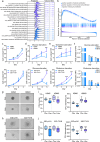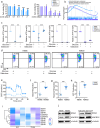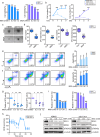GPX1 confers resistance to metabolic stress in BCR/ABL-T315I mutant chronic myeloid leukemia cells
- PMID: 40346054
- PMCID: PMC12064725
- DOI: 10.1038/s41420-025-02502-z
GPX1 confers resistance to metabolic stress in BCR/ABL-T315I mutant chronic myeloid leukemia cells
Abstract
Chronic myeloid leukemia (CML) harboring BCR/ABL-T315I mutation has been a challenging obstacle for targeted therapy due to the acquired resistance to tyrosine kinase inhibitor (TKI)-based therapy. Thus, it is especially urgent to investigate more effective therapeutic targets to overcome T315I-induced resistance. Here, we reported that BCR/ABL-T315I mutant CML cells possessed a long-term proliferative capacity and tolerance to metabolic stress. Importantly, we also found that selenoamino acid metabolism was increased in the bone marrows of BCR/ABL-T315I patients compared with non-T315I patients by GSEA from RNA-Seq data. Indeed, GPX1 was highly expressed in T315I mutant cells, while knockout of GPX1 significantly suppressed cell proliferation and triggered apoptosis under glucose-deprived condition. GPX1 knockout showed decreased cell metabolism signaling as well as mitochondrial gene expression by RNA-Seq. Mechanistically, GPX1 maintained mitochondrial activity and oxygen consumption rate (OCR), retaining mitochondrial redox homeostasis and oxidative phosphorylation (OXPHOS). Additionally, mercaptosuccinic acid (MSA), a GPX inhibitor, inhibited CML colony formation and induced cell apoptosis under glucose-free condition. Therefore, GPX1 is a promising therapeutic target to overcome drug resistance induced by the T315I mutation, which provides a novel approach for BCR/ABL-T315I CML treatment by disturbing mitochondrial OXPHOS.
© 2025. The Author(s).
Conflict of interest statement
Competing interests: The authors declare no competing interests. Ethics approval: All methods were performed in accordance with the relevant guidelines and regulations. All specimens were obtained with informed consent from the participants, and this study was approved by the Ethics Committee of Nanfang Hospital, Southern Medical University (NFEC-2021-085).
Figures





References
-
- Cortes J, Pavlovsky C, Saußele S. Chronic myeloid leukaemia. Lancet. 2021;398:1914–26. - PubMed
LinkOut - more resources
Full Text Sources
Miscellaneous

